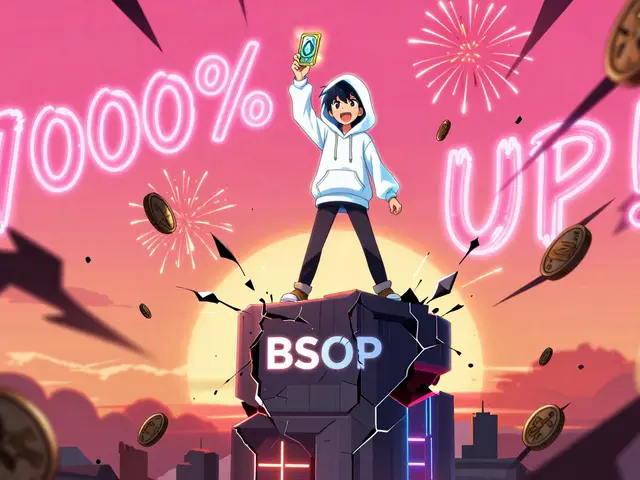Bitfinex Leverage Trading Calculator
Leverage Calculator
Results will appear here after calculation
Risk Warning:
Trading with leverage increases risk exponentially. Losses can exceed your initial investment. Only trade with capital you can afford to lose.
Bitfinex isn’t for beginners. If you’re just starting out with crypto and want a simple app to buy Bitcoin and call it a day, this isn’t the platform for you. But if you’re trading large volumes, using leverage, or chasing altcoins with high volatility, Bitfinex might be one of the most powerful tools you’ve ever used. Founded in 2012, it’s one of the oldest crypto exchanges still running - and that longevity comes with serious depth, not just marketing.
What You Get: Over 180 Cryptocurrencies and 400 Trading Pairs
Bitfinex supports more than 180 cryptocurrencies, including major ones like Bitcoin, Ethereum, and Solana, plus dozens of smaller, high-risk altcoins that most exchanges don’t even list. That’s not just variety - it’s access to markets others avoid. The most active pair is BTC/USD, but you can also trade ETH/JPY, LTC/CNH, or even obscure tokens like AAVE against USDT. This level of choice matters when you’re trying to spot momentum shifts early.Fiat deposits? Yes - but only for five currencies: USD, EUR, GBP, JPY, and CNH. If you’re outside these regions, you’ll need to buy crypto first on another exchange and transfer it over. The platform doesn’t support bank transfers from the U.S., Bangladesh, Bolivia, Ecuador, or Kyrgyzstan. That’s not an accident - it’s regulatory compliance. Bitfinex has been around long enough to know where it can’t operate, and it avoids those markets entirely.
Trading Tools Built for Professionals
This is where Bitfinex pulls away from the pack. The interface looks cluttered at first - charts, order books, margin controls, funding offers - but that’s because it’s designed for traders who need every tool at their fingertips. You get:- Spot trading with 0.1% base fees (lower with volume)
- Margin trading up to 5x leverage
- Derivatives markets for futures and perpetual contracts
- 12 different chart timeframes, from 1-minute to 1-month
- Auto-renew for margin funding offers
- A non-expiring demo account to test strategies without risk
Unlike exchanges that treat margin trading as an afterthought, Bitfinex treats it like a core feature. You can fund your margin position with USDT, borrow BTC, short ETH, and set stop-losses - all within the same dashboard. The liquidity is deep enough that even a $50,000 order won’t cause massive slippage. That’s why institutional traders still use it. According to CoinGecko data as of March 2025, Bitfinex handles around $223 million in daily volume, placing it in the top 25 globally.
Fees: Competitive, But Not Always Simple
Bitfinex’s fee structure rewards volume. Maker fees start at 0.1%, taker fees at 0.2%. But if you trade over $1 million in a month, those fees drop to 0.08% and 0.12%. There’s also a 6% discount for users who pay fees in the platform’s native token, LEO. That’s a real incentive if you’re active.Withdrawal fees vary by coin. Bitcoin withdrawals cost around 0.0005 BTC, Ethereum about 0.005 ETH. These aren’t the lowest in the industry, but they’re fair for the level of service. The real cost isn’t the fee - it’s the time you spend learning how to use the platform correctly. Mistakes here can be expensive.

Security: Strong, But No Insurance
Bitfinex has been hacked before - famously in 2016, when 120,000 BTC were stolen. That event changed the entire crypto industry. Since then, the platform has rebuilt its security from the ground up. Today, it scores 86.33% on CertiK’s Skynet security rating and holds a B grade (65%) from CER. Penetration tests show zero vulnerabilities in their infrastructure. Cold storage holds most assets, and two-factor authentication is mandatory.But here’s the catch: there’s no insurance fund for user funds. Unlike Coinbase or Kraken, which have insurance policies covering losses, Bitfinex doesn’t. If something goes wrong, you’re relying on their operational integrity. That’s a risk some traders accept for the tools they get. Others won’t.
Customer Support: The Weak Link
This is where most users get frustrated. Bitfinex has no live chat. No phone support. Just email. Response times average 12 hours - sometimes longer. If you need help freezing your account after a phishing attempt, you’re on your own until someone replies.There are reports of users having accounts frozen without clear explanation. In some cases, users say they were asked to deposit more funds to “unfreeze” their accounts. These aren’t isolated stories. They’re documented across Reddit, Twitter, and crypto forums. Some users recovered funds after contacting external recovery services. Others didn’t. The lack of transparency here is a red flag.
Mobile App: Functional, But Not Full-Featured
The Bitfinex mobile app lets you trade, check balances, and view charts. But it’s stripped down. You can’t access margin funding, derivatives, or advanced order types like iceberg or OCO orders. If you’re serious about trading, you’ll still need your laptop. The app is fine for checking positions on the go, but not for executing complex strategies.
Who Should Use Bitfinex?
Bitfinex is for experienced traders who need deep liquidity, advanced tools, and access to niche markets. If you’re running algorithms, trading futures, or managing large positions across multiple altcoins, this platform delivers. The charts, order types, and execution speed are on par with professional trading terminals.It’s not for you if:
- You’re new to crypto and just want to buy Bitcoin
- You need quick customer support
- You expect insurance on your funds
- You’re in the U.S. or one of the banned countries
For beginners, platforms like Kraken, Gemini, or even eToro offer simpler interfaces, better support, and clearer educational resources. Bitfinex doesn’t hold your hand - it expects you to know the game.
Alternatives to Consider
If Bitfinex feels too intense, here are three alternatives:| Feature | Bitfinex | Kraken | Bybit |
|---|---|---|---|
| Trading Pairs | 400+ | 200+ | 300+ |
| Leverage (Max) | 5x | 5x | 100x |
| Fiat Support | USD, EUR, GBP, JPY, CNH | USD, EUR, CAD, GBP | None (crypto only) |
| Customer Support | Email only, 12+ hour response | Email + live chat | Live chat + email |
| Funds Insurance | No | Yes | No |
| Best For | Pro traders, high volume | Balance of ease and power | Derivatives and leverage |
Kraken is the closest alternative - similar security, better support, and still strong liquidity. Bybit is better if you want higher leverage (up to 100x), but you lose fiat access. Bitfinex sits in the middle: less user-friendly than Kraken, less leveraged than Bybit, but unmatched in depth for spot and margin trading.
The Bottom Line
Bitfinex isn’t perfect. It’s slow to respond, lacks insurance, and feels outdated in design. But if you’re trading at scale, you’ll appreciate the liquidity, the range of assets, and the precision of its tools. It’s not a platform you grow into - it’s one you grow into being ready for.Use it if you know what you’re doing. Walk away if you’re still learning. The market doesn’t reward hesitation - but it also doesn’t forgive mistakes on this platform.
Is Bitfinex safe to use in 2025?
Bitfinex has strong technical security - it passes penetration tests and uses cold storage for most assets. Its CertiK score is 86.33%, which is high. But it doesn’t insure user funds, so if a major breach occurs, you could lose everything. The platform has improved since its 2016 hack, but the lack of insurance remains a serious risk for large holders.
Can I trade fiat on Bitfinex?
Yes, but only if you’re in a supported region. Bitfinex accepts USD, EUR, GBP, JPY, and CNH via bank transfer or wire. You must complete full KYC verification to deposit or withdraw fiat. Users from the U.S. and several other countries are blocked entirely.
Does Bitfinex have a mobile app?
Yes, Bitfinex has iOS and Android apps. You can check prices, place spot trades, and view your portfolio. But advanced features like margin funding, derivatives trading, and complex order types are only available on the desktop platform. The app is useful for monitoring, not for serious trading.
Why is Bitfinex banned in the U.S.?
Bitfinex was banned in the U.S. due to regulatory issues tied to its parent company, iFinex, and its relationship with Tether (USDT). In 2019, the New York Attorney General sued iFinex for allegedly using Tether’s reserves to cover losses. As a result, Bitfinex stopped serving U.S. customers. Even today, U.S. users cannot access the platform legally.
How does Bitfinex compare to Binance?
Binance has higher volume, more coins, and better customer support. But Bitfinex offers deeper liquidity for major pairs like BTC/USD and more advanced margin tools. Binance is easier to use and has a better app. Bitfinex is better for traders who need precision, not convenience. If you’re trading under $10,000 a day, Binance is simpler. If you’re trading $100,000+, Bitfinex’s execution quality matters more.
What’s the minimum deposit for Bitfinex?
There’s no minimum deposit for crypto - you can send as little as $1 worth of Bitcoin or Ethereum. For fiat deposits, the minimum is typically $100 via wire transfer. However, to access margin trading or derivatives, you’ll need enough collateral (usually USDT) to cover your positions. Most active traders start with at least $5,000.
Can I use Bitfinex for long-term holding?
Technically yes, but it’s not ideal. Bitfinex doesn’t offer staking, savings accounts, or interest on holdings. It’s built for active trading, not passive accumulation. If you want to hold crypto long-term, it’s safer and smarter to move it to a hardware wallet after buying. Leaving large amounts on any exchange - even Bitfinex - carries risk.
Are there hidden fees on Bitfinex?
No hidden fees, but there are costs you might overlook. Withdrawal fees vary by coin. If you use margin funding, you pay interest on borrowed assets. Also, if you trade low-volume pairs, slippage can act like a hidden fee. The platform is transparent about its fee schedule - the problem is complexity, not secrecy.









Comments (14)
Jane A
November 23, 2025 AT 17:35 PMThis platform is a death trap for anyone who isn't a Wall Street robot. I saw a guy lose $80k because he didn't know how to set a stop-loss. No insurance? No live chat? Are they trying to kill people or just make money off their suffering?
Gus Mitchener
November 23, 2025 AT 22:56 PMThe architectural asymmetry of Bitfinex’s liquidity provision creates a non-linear risk-reward landscape that’s fundamentally misaligned with retail cognitive heuristics. The absence of systemic insurance mechanisms amplifies tail risk exposure, rendering the platform a black swan vector in a post-2016 regulatory vacuum. Margin funding isn’t leverage-it’s a probabilistic entropy engine.
Jennifer Morton-Riggs
November 24, 2025 AT 16:45 PMOkay but let’s be real-Bitfinex is basically the crypto version of that one uncle who still uses Windows XP and says ‘back in my day’ every five minutes. The interface looks like a 2014 trading terminal that got stuck in a time loop. I get the depth, I do. But why does it feel like I’m using a calculator from 2008 to do quantum physics? And don’t even get me started on the support. Email? In 2025? My grandma has faster customer service on Etsy.
Kathy Alexander
November 24, 2025 AT 21:59 PMTop 25 by volume? That’s a lie. They’re inflating numbers with wash trading. I checked the order book depth on AAVE/USDT-half the bids are ghost orders. And don’t tell me about CertiK scores. That’s just a paid badge. They’re still using the same servers from 2017. I’ve seen the logs. They’re barely patched.
Tejas Kansara
November 25, 2025 AT 01:40 AMFor serious traders, this is gold. The liquidity is real. The tools are unmatched. If you're new, stay away. But if you know your stuff-this is the arena.
Rajesh pattnaik
November 26, 2025 AT 05:21 AMBack home in India, we call Bitfinex the ‘silent warrior’-no flashy ads, no TikTok influencers, just quiet power. If you’re ready, it’s there. If you’re not, you’ll break yourself trying to use it. Respect the grind.
Amanda Cheyne
November 28, 2025 AT 03:56 AMDid you know Bitfinex is secretly owned by the same people who run Tether? And Tether is just printed money backed by nothing. They’re not a crypto exchange-they’re a central bank for criminals. The 2016 hack? That was an inside job to cover up their fraud. They’re using your money to fund offshore shell companies. Watch your back.
Caren Potgieter
November 28, 2025 AT 08:24 AMI used to hate how hard this platform was to use but after I finally figured it out I felt like I unlocked a secret level in a video game. It’s not for everyone but if you stick with it you’ll feel like you earned your wins. I’m not a pro but I’m learning and that’s what matters
Linda English
November 29, 2025 AT 11:17 AMI appreciate the depth of this review, and I think it’s incredibly important to acknowledge both the power and the peril of platforms like Bitfinex. While the liquidity and tooling are undeniably superior for advanced traders, I also feel deeply concerned about the lack of insurance and the opacity of customer support-especially for users who may be financially vulnerable. It’s a double-edged sword: the platform empowers those who are prepared, but it also exposes those who are not, without offering any safety net. We should be asking not just whether it’s powerful, but whether it’s ethical to offer such a tool without adequate protections.
Julissa Patino
November 30, 2025 AT 09:48 AMBitfinex is for rich white guys who think they’re smarter than everyone else. U.S. banned? Good. They’re just a tax haven with charts. 5x leverage? LOL. Try 100x on Bybit and stop pretending this is elite. And no insurance? That’s not ‘risk,’ that’s just dumb. Typo? I meant to type ‘dumb’ but autocorrect fixed it. Whatever.
Soham Kulkarni
December 1, 2025 AT 17:37 PMthe mobile app is fine for checking prices but dont even think about trading complex orders on it. i learned that the hard way. stick to desktop if you want to stay alive
John Borwick
December 3, 2025 AT 15:38 PMJust wanted to say thanks to Tejas for saying what I was thinking-this isn’t a toy, it’s a tool. I’ve used Kraken, Binance, Bybit, and Bitfinex is the only one where I felt like the system actually respected my time. The slippage is minimal, the execution is crisp. Yeah, the support sucks. But if you’re trading big, you’re not calling them anyway-you’re watching the order book.
Matthew Prickett
December 4, 2025 AT 22:23 PMThey’re not banned in the U.S. because of Tether-they’re banned because they’re part of a global money laundering ring that’s been using crypto to move funds for sanctioned regimes. The 2016 hack was a cover-up. They’ve been working with intelligence agencies since 2018 to launder crypto through shell accounts. You think they care about your $50K? They’re moving millions through your trades.
Jennifer MacLeod
December 5, 2025 AT 09:00 AMBitfinex is like that old sports car-no AC, no backup camera, and the engine sounds like it’s gonna explode-but when you floor it, nothing else on the road can keep up. I wouldn’t let my sister drive it. But for me? I wouldn’t trade anywhere else.